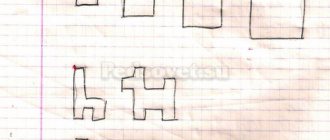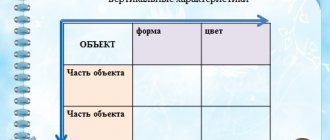Preschool age is a period of intense sensory development. The child learns about the world through the senses and masters ways of manipulating objects. Sensory is the basis for the emergence of cognitive mental processes and speech. To develop a child’s sensory system, no special conditions or activities are required; you can create sensory games for children 2-3 years old with your own hands.
A game for sensory development.
The concept of sensory
“The child’s mind is at the tips of his fingers” - the words of the Soviet teacher V. Sukhomlinsky accurately reflect the tasks of raising a preschooler. In early childhood (from 1 to 3 years), development occurs through objective activity, in which imaginative thinking is formed. It is important for children to taste an object, feel its structure, and touch the surface. By interacting with surrounding objects, the child learns to perceive and analyze information. The senses and corresponding analyzers help him in this:
- visual;
- auditory;
- tactile;
- olfactory;
- taste.
Through these systems, ideas about the surrounding reality are formed, which are enshrined in sensory standards - generally accepted properties of objects. Such standards are shapes, colors, size, taste, sound level, temperature.
The sensory system of a preschooler includes two interconnected aspects:
- Mastering ideas about the properties and relationships of objects. The child is looking for new ways to interact with previously unknown objects.
- Mastering new perceptual actions that allow you to more fully perceive the world around you. The child can perform operations not with objects, but with symbols, and becomes able to solve simple problems in his mind, without resorting to trial and error.
Sensory development allows:
Sensory skills improve attention.
- enrich your vocabulary;
- form the correct structure of speech;
- improve cognitive mental processes: memory, attention, thinking, perception;
- develop imagination;
- obtain complete information about the surrounding reality;
- improve communication skills.
A child who has a developed system of perception and processing of information is able to navigate perfectly in the conditions of the modern world.
Sensory education in children 2-3 years old
In order to purposefully influence the sensory skills of preschoolers, it is necessary to know the main stages of sensory development, be able to diagnose its level and correlate it with age-related characteristics. Among them are the following:
- Getting to know an object through perception through the senses. The child puts it into his mouth, tastes it, feels it, smells it, evaluates its shape and size.
- Formation of skills to correlate the spatial arrangement of objects, connect objects and their parts. The child evaluates the sizes of objects and their relationships. To do this, you need to teach children to put one object into another (games with a pyramid work well), string beads on a cord, and push small objects into various holes. The child becomes familiar with composite objects, with the concept of the whole and parts. Games with large puzzles, cut-out pictures, and construction sets of 2-4 elements will help him with this. At the first stage, the child is able to assemble a matryoshka doll from 2 elements.
- Mastering ways to practically distinguish the properties of objects. A preschooler learns to compare two similar objects through practical actions: putting one on top of the other, the relationship between shape and color. At the second stage, the child is able to assemble a matryoshka doll from 3 elements.
- Formation of manipulative actions with an object based on repeated repetition. After practical manipulations with an object, the child is able to visually correlate the size and shape of objects using only mental operations. He can group objects according to one characteristic, select 3 objects according to a given pattern, and is able to sort objects from smallest to largest. At this stage, the preschooler assembles a five-seater nesting doll.
- Complicating the conditions for performing actions that require correlation according to one of the characteristics. The child groups objects according to several characteristics, is able to correlate 6 or more colors with each other, and visually selects a pair of objects according to given characteristics.
- Using learned actions in solving practical and cognitive problems. The child is able to reproduce acquired knowledge and skills, differentiate the properties of objects, and apply subject standards in solving assigned problems. At this stage, a 3-year-old child can correctly assemble a pyramid of 8 rings in descending order of their size.
Sensory education is a targeted didactic impact on the sensory systems of preschool children, which becomes more complex with each new stage of sensory development. Creating conditions for the comprehensive development of the senses is the task of parents and teachers of preschool educational and developmental institutions.
Card index of didactic games on sensory education for young children 2-3 years old
Didactic material for sensory education - systematized sets of objects or pictures that give children the opportunity to practice identifying certain characteristics of objects, comparing some objects with others, grouping objects, and solving problems on their spatial arrangement. As cognitive abilities develop, the material becomes more complex.
Learning takes place in a playful way so that preschoolers remain highly motivated to study.
Requirements for educational games:
- safety;
- visibility;
- naturalness of materials;
- brightness and naturalness of colors;
- availability;
- age appropriate.
Sensory fun for all ages
There are also such fun things for the preparatory period - speech serpentine, which you can also do yourself. We draw a serpentine road on paper, and removable elements such as cards and pictures are attached along the sides of each turn. The child must, following the serpentine, name syllables, letters, and images. You can move in any way you like: paving the way with buttons, pebbles, walking with your fingers, moving a car.
Also, “for a snack,” I suggest making this didactic sensory fun from matchboxes: on top of the box we paste an image of an animal, a bird that makes recognizable sounds: meow, woof, moo, coo-ka-re-ku, co-co-co, coo -ku, etc. On the inside of the box at the bottom, we write these sounds in readable letters. The child must choose the right sound for the picture. If you can’t read yet, read it yourself, and the child picks it up by ear.
I think you have enough ideas for implementation today. If you have any additions, please share them, as well as links to my articles. In addition, I invite new subscribers to our company.
Sincerely, Tatyana Sukhikh! Till tomorrow!
By the way, I recommend reading:
Games with clothespins
Clothespins are an accessible material for developing fine motor skills. To attach or unhook a clothespin, the child uses his fingers and practices exciting movements. Children under 2 years old use their entire hand to grasp, and games with clothespins will help coordinate the precise work of their fingers. Thanks to the color scheme of clothespins, you can study colors and form mathematical concepts.
Games with clothespins develop fine motor skills.
Using your imagination, you can offer your child many options for games with clothespins, including:
- Wash. Stretch a rope between two chairs and offer to hang the doll's clothes on it, securing with clothespins.
- Constructor. Using clothespins, three-dimensional figures, robots, animals, and vehicles are created.
- In the animal world. Print figurines of hedgehogs and bunnies. Attach needles in the form of clothespins to the hedgehog, and make ears out of them for the bunny.
- Polyanka. Cut out the sun, cloud, grass, tree from colored cardboard. The child attaches clothespins of the appropriate color to the stencil to create a three-dimensional picture.
- Who eats what? Print out the faces of different animals and the food they prefer. Cut a circle out of cardboard and divide it into sectors. Stick a picture of food on each one. Glue the faces onto the clothespins with tape. The child attaches clothespins with animals to the sector where suitable food is depicted.
Game methods for forming ideas about color
The main focus is on color recognition exercises and games. With their help, a preschooler can become familiar with the generally accepted system of shades and color tones, which are included in the form of transitional phrases.
These games are very important, because children, when perceiving color in the environment, drawing it with paints and pencils, are not able to independently learn to systematize shades and tones.
G.S. Shwaido offers his own model for constructing games for color discrimination and recognition. First, the child must remember colors that are close to each other. Then he must learn to distinguish colors by dark and light shades.
After this, children should learn to distinguish between shades of one color. First, choose two shades. Then several.
To firmly grasp sensory standards, you need to repeat games many times. But repetition needs to be organized in different ways. If you repeat didactic games without changes, this will give children the opportunity to consolidate acquired skills and knowledge during the exercises.
But if you make familiar games a little more complicated, it develops interest in them. Solving new problems brings children a sense of satisfaction and joy, and children are fueled by a desire to be mentally active.
Games for sensory development for children of primary preschool age 3-4 years
The play of a 4-year-old child becomes more complex and becomes the leading type of activity in which development occurs. The child acquires speech skills that allow him to describe the properties of an object. Basic ideas about the properties of objects are expanded, the child orients himself in the variety of shapes and colors. Games in early preschool age are aimed at:
- to gain knowledge about the senses;
- to expand vocabulary for describing objects;
- on the development of sensory systems;
- to highlight the distinctive features of objects;
- to carry out practical activities.
Lesson objectives
Sensory development through didactic games has the following features:
- teaches you to perceive the world around you through all your senses;
- forms a system of basic actions that are a reaction to external stimuli;
- teaches you to explore the world around you;
- forms a system of sensory patterns;
- teaches you to independently apply sensory patterns depending on the situation.
The child learns about the world around him through sensations. Therefore, the ability to perceive all channels of information, not limit one’s own feelings and interpret them correctly will be useful for children’s development. Sensory culture is the key to comprehensive development, successful activity, and the formation of a thinking personality that strives to understand the world around us.
Note! Also, without sensory development, it will not be possible to teach a child to understand art and find beauty in it.
Handy materials for games and development of tactile sensations
When choosing a material to work with the senses, you should give preference to natural objects - smooth pebbles, sharp cones, soft fabric, rough wood, crumbly grains, fluffy fur. Tactile sensations are important for children; they learn to distinguish object structure and perceive information through touch. Children strive to touch an unfamiliar object, feel it from all sides, and form an impression based on tactile information.
A variety of materials will allow the child to develop tactile sensitivity and will have a beneficial effect on fine motor skills. The finger massage that the child will receive during tactile perception will relieve neuromuscular tension. By getting acquainted with various natural materials, the child gets an idea of the richness of the world around him.
DIY didactic games
Didactic educational games do not have to be purchased in a specialized store. You can create them yourself and involve your child in the process. This will make him want to learn new things while playing. Household items that a person encounters every day are suitable as equipment. This will introduce the preschooler to everyday objects and avoid additional cash expenses.
Finger dry pool
Dry pool is a game for the development of fine motor skills, which includes finger gymnastics. Fill a deep bowl 12-15 cm high halfway with dry peas. The child dips his hands into the filler, sorts out the peas, and scatters them. In this way, self-massage of the fingers occurs.
Games in a dry pool are accompanied by music or poetry. You can put small toys at the bottom of the bowl, which you need to find and describe with your eyes closed. The game is suitable for children two to three years old.
Salt dough beads game
Children are invited to create beads as a gift for their mother from multi-colored rings. The teacher makes salt dough rings in advance and dries them in the oven. You can buy the dough at the store or make it yourself. For this you will need:
In the salt dough beads game, children string beads onto a string.
- flour - 1 glass;
- salt - 1 glass;
- starch - 1 tbsp. l.;
- water - 1 ½ cups;
- colored gouache.
Dilute starch in ½ glass of cold water, pour 1 glass of boiling water. Mix half a glass of the resulting solution with flour and salt. Knead the dough, paint it in different colors. Form rings.
During the lesson, children string beads onto a cord and form a decoration.
Guide “put the eggs in your houses”
The teacher paints a cardboard container for eggs in 4 colors: red, blue, green, yellow. Boxes of chocolate eggs (kinder surprise) are covered with appropriate colored paper. Children place colorful eggs into the appropriate cells.
"Tactile Box"
The basis of the interactive manual is a box, a saucepan, and a plastic container with a lid. It is filled with natural materials (cereals, sand, flour, shells, stones, leaves). You can add paper, cotton wool, fabric, toys to the box. The box is supplemented with tools - a spoon, spatula, glasses, muffin tins. The child studies the contents of the box, learns to manipulate different objects, and becomes familiar with various tactile sensations. You can play with the contents of the box according to the instructions of an adult or leave room for the free creativity of a preschooler.
Game "colorful sticks"
Colored counting sticks - Cuisenaire's manual. It is a set of 116 plastic sticks in 10 different colors and sizes. The smallest stick is 10 mm long, the next ones increase by 10 mm. Sticks of the same length are colored the same. Using the manual allows children to develop their understanding of numbers based on counting and measurement, form spatial concepts, and study the “more-less” relationship. You can make your own sticks or buy them at the store.
Wonderful pouch
To play you will need a large thick fabric bag and various small objects: pebbles, figures, balls and beads, coins, fabric, cones. During the game, tactile perception develops. Children take turns putting their hand into the bag and describing the object they felt. The task is to guess what item is in the bag. The lesson is carried out both individually and in a group in kindergarten.
Constructor
Construction is an activity that is aimed at creating new objects from small parts. By assembling the details of the construction set, the child develops imagination, fine motor skills, thinking, and studies colors and shapes.
An adult can offer to assemble a figure according to a model, give an oral task, or allow the child to experiment.
"Spider in the Clearing"
To play, you will need a plastic transparent bucket with a lid; holes are made in it for lacing and attaching additional parts. A spider is glued to a lid made of colored paper. The eyes are made from plastic bottle caps, painted in suitable colors, and connected to the base. Laces are added to the paws and inserted into the holes. From them the child “weaves a web.”
Small objects and ribbons are placed in the bucket, which can be pushed through holes of different diameters. There are many options for manipulating the manual, so children will come up with a new game with the spider every time.
Formative environment and game methods
According to R.A. Kurashova, we can highlight a subject-based developmental environment, which is one of the conditions for the development of sensory standards in preschoolers.
Today, as the education system improves, as the principles of humanization of the educational process are introduced, great importance is attached to the creation of a formative environment.
The environment, which includes the child's environment, consists of the family, immediate environment and social environment. The environment can both enhance and inhibit a child’s development. But she cannot but influence his development at all.
The developing subject environment is a complex of objects of the material world with which the child interacts. It allows you to model the content of the child’s physical and spiritual appearance.
In order for didactic games to produce results, you need to follow general didactic principles in their organization.
For example, one must adhere to the principle of consistency and systematicity, which is manifested in the fact that the knowledge system should be transmitted to children in a logical sequence, taking into account the cognitive capabilities of students. Another principle is the principle of learning. It involves organizing a process of several steps. It produces more results if you take fewer breaks, stay consistent, and avoid uncontrollable moments.
Based on all this, didactic games should be carried out sequentially from simple to complex.
According to V.N. Avanesova, during classes that are based on the direct influence of adults on the teacher, it is impossible to implement all the goals of sensory education: didactic games still play a large role.
The researcher believes that in some cases games are a specific playful form of conducting classes. They can be organized with all preschoolers during classes. In other cases, games should be used in everyday life, when the child plays independently.







